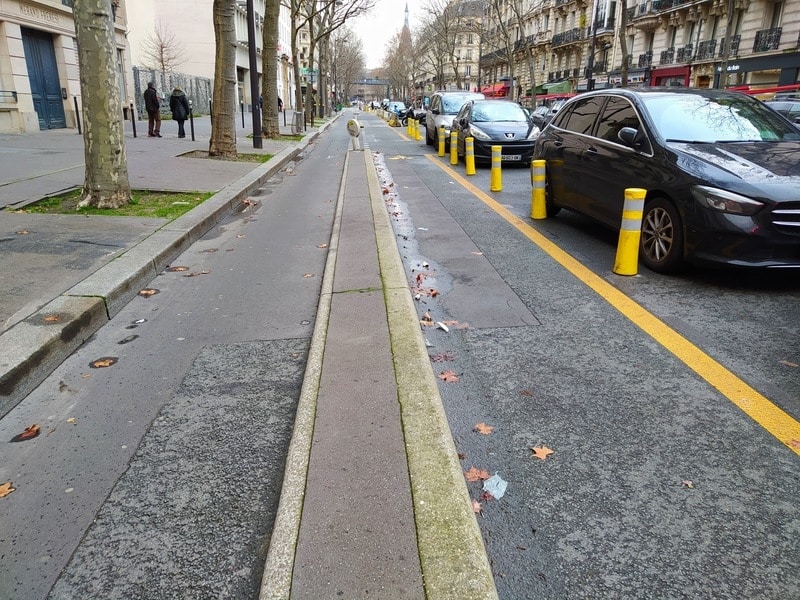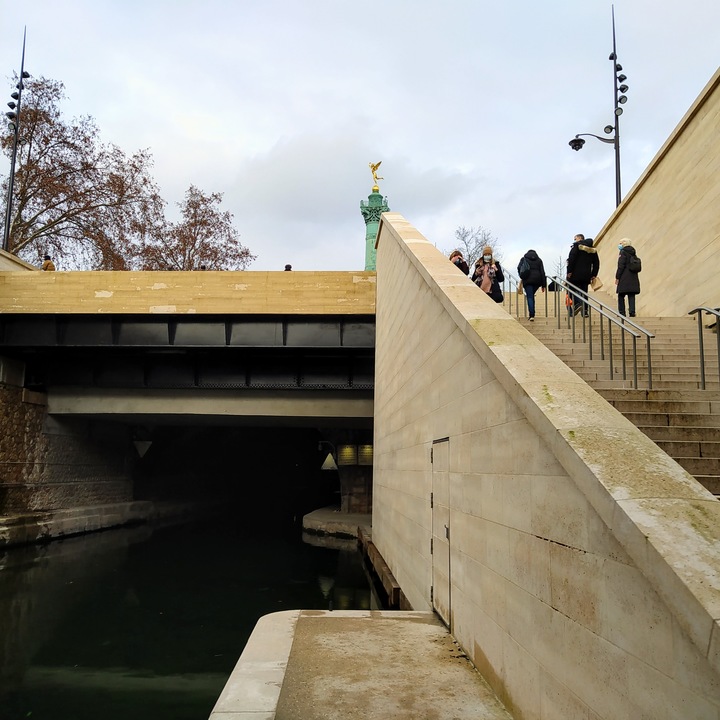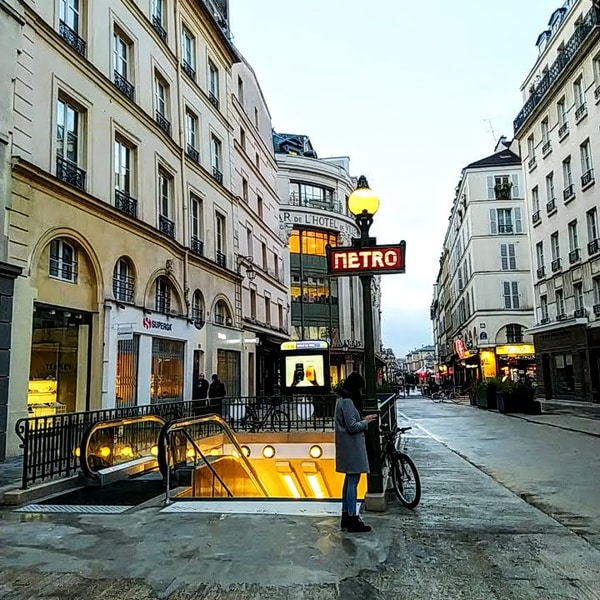Last time, we began a look back at 2020 in Paris transport history by digging into the effects of the coronavirus pandemic on long-distance transport. Today, we zoom in on the capital to look at the changes in local public transport in an eventful year.

Covid-19 ridership impact
The lockdowns naturally had a major impact on ridership on Paris’s public transport network. The first lockdown, between March and May, was especially heavy. The transport lines of city transit authority RATP1 saw just 5-6% of their normal footfall during this period; on the Transilien suburban rail network2 the ridership figure was barely higher, at 10% of normal. Unsurprisingly, service was also reduced during this period. The metro and RER opened later and closed earlier than normal, while some 50 metro stations were closed. Tram service was at 40% of normal levels, and the metro saw similar cuts, with line 1 offering 50% of its usual service.
The second lockdown was less strict, but ridership was still significantly below normal levels, down 70% overall and 50% at rush hour. Peak service across Île-de-France was kept intact throughout the period, but in off-peak hours all but three metro lines (1, 13 and 14) saw their headways double, while some bus, tram and suburban rail services were also cut. The RER was virtually untouched, with only line D seeing some reductions.
Of course, the limited service reductions were far from sufficient to make up for the loss of revenue faced by Paris’s transport providers. The region’s estimated losses for 2020 stand at an eye-watering €2.24 billion, with a further €1 billion estimated for 2021. The central government has pledged a total of €2.5 billion in support.
Covid-19 adaptations
A few adaptations have had to be made to the transport offering to make it as covid-safe as possible. Most importantly, masks have been required for travel on public transit across France since the end of the first lockdown. Meanwhile, three quarters of Paris’s bus stops have been equipped with hand gel dispensers, and bus doors have been adjusted so that drivers are entirely separated from boarding passengers. Finally, the RATP mobile app has a useful feature allowing passengers to report the level of crowding on the transport lines they take. This information is used to inform travellers of current levels, allowing people with multiple options to choose a more lightly occupied route.
Active travel and reduced space for cars
As I wrote last summer, the pandemic has had a major impact on the streets of Paris, with 50 km of new coronapiste cycle lanes (most notably the closure of the rue de Rivoli to through motor traffic), widened pavements, and parking spaces occupied by restaurants. Although restaurants and cafés across France have been closed since October, the city’s terrasses éphémères are still there, with various wooden structures standing in wait for when they can once again welcome customers. These are not without controversy, especially as many are in a rather dilapidated state after months of idleness.

But all the pandemic has done is accelerate an already established trend. For decades, Paris has been realigning itself away from dependence on the private car, opening up spaces previously inhabited by polluting vehicles for other uses. As early as the mid-1990s, centre-right mayor Jean Tiberi closed the expressways on the banks of the Seine to motor traffic on Sundays and launched a plan to build cycle lanes around the city. In 2007, under Socialist mayor Bertrand Delanoë, the Vélib’ cycle hire scheme was launched. By 2010, Paris’s bus lanes were widespread and high-quality enough to impress a visiting transit consultant. And in January 2013, a 2.4 km stretch of highway on the left bank of the Seine was definitively closed to motor vehicles.
Elected in 2014, Delanoë’s protégée Anne Hidalgo took this ball and ran with it. Her most iconic achievement in her first term was surely the complete pedestrianisation of the Voie Georges Pompidou on the right bank of the river. Alongside this, new, high-quality cycle lanes have sprung up across the city, and several major road junctions have been redesigned to favour pedestrians. Though a controversial figure, the incumbent was decisively reelected in June 2020.

Work progressed throughout the year on the Place de la Bastille, once a somewhat dangerous roundabout. In a similar approach to that already taken at République, one side of the roundabout has been pedestrianised, with the formerly one-way roads making up the rest of the junction switched to two-way traffic. It is now possible to walk right up to the historic July Column, once surrounded on all sides by cars. But perhaps the crown jewel of the newly reordered plaza is the staircase leading down to the Bassin de l’Arsenal. Passing under the metro platforms of line 1, pedestrians can access the water directly and enjoy the peaceful atmosphere and beautiful views of the canalside.
One of Hidalgo’s election promises last summer was to pedestrianise the roads that line the Canal Saint-Martin in eastern Paris. Hoping to recreate the success of the new riverside parks, these closures are at least as controversial. Thus far, the roads in question are closed to motor vehicles on Sundays.
Regulating free-floating electric scooters
The first free-floating electric scooters were rolled out in Paris in 2018, but were poorly regulated and were often found cluttering narrow pavements and car parking spaces. In 2020, this changed.
In 2019, new parking zones were created specifically for these vehicles; as of 2020, these are the only authorised locations to leave them. Furthermore, in December 2019, bidding was opened to restrict electric scooter services to a small number of providers. In summer 2020, three operators were chosen – Dott, Lime and TIER – to deploy up to 5000 vehicles each across the city. Since September, these are the only authorised services.
Though I haven’t used any of these scooters myself, my personal experience of walking in Paris has been much improved since the increased regulation: scooters are no longer left on pavements or in the roadway, and it’s less common to see riders on the pavements (an offence punishable by a €135 fine).

Montmartre funicular
The cabins of the Montmartre funicular3, which carries tourists up the hill to the Sacré Cœur, were renovated in 2017 and 2019. In 2020, it was the turn of the stations. This work was suspended during the first lockdown and completed in June for a reopening on 1 July. The delay can’t have posed much of a problem, given that most users of the service are visitors to the city, who were few and far between during these months.
Suburban rail
A few changes could be seen on the suburban rail network in 2020.
After some delay partly due to the pandemic, RER line B saw its first renovated MI84 trains in October. This renovation, conducted by Alstom, is far from purely aesthetic: it includes refrigerated ventilation, security cameras, LED lighting and, most importantly, a significant increase in the number of seats, from 216 to 312 per trainset.
In December, Transilien line N got its first Regio2N trains, destined to replace the VB2N and Z8800, built in the 1970s and 1980s. The VB2N are the last remaining locomotive-hauled carriages on the network. Constructed by Bombardier, the Regio2N reflects its suburban service with alternating single- and double-decker carriages. The spacious single-storey cars are intended for short journeys, with standing room and a few seats for passengers who want to wait near the doors. The two-storey coaches are intended for longer, seated journeys – the longest on this line take over an hour. The Regio2N was already in use for various regional services around France as well as on Transilien line R and RER line D.

Further north, line L saw its last service from the 40-year-old Z6400, while to the east line P said goodbye to the RIB and RIO, stainless-steel locomotive-hauled trainsets dating to the 1970s and 1980s. Line P also welcomed newly renovated Z20500 trains; this was mostly a decorative update, but included the addition of USB charging points and films on the windows to reduce summer heat on these non-air-conditioned trains.
Tramway
The tramway network of Île-de-France is developing rapidly. Originally, line T9 was set to open at the end of the year, but the pandemic pushed this back to spring 2021. This line, in the south between the Porte de Choisy and the town of Orly, is set to replace the overcrowded 183 bus.
Covid-19 notwithstanding, one update to the tram network was completed in 2020: an extension of tram-train line T4. A new branch to this northeastern line was opened in December 2019 linking Gargan with the Montfermeil Arboretum, and in August 2020 this was extended to Hôpital de Montfermeil.

Metro
The Paris metro is due to see huge changes in the 2020s, with the Grand Paris Express project of new suburban lines set ultimately to double the length of the network. Crucial to the success of this suburban project is its integration into the present network, a major part of which is the extension of line 14 to the north and south. By 2024, this line should reach the station Saint-Denis Pleyel in the north and Orly airport in the south. Saint-Denis Pleyel will be near the Olympic Village for the 2024 games, and will ultimately serve as an interchange with lines 15 and 16, the former of which will form a loop around Paris, the latter passing through the eastern suburbs. The extension to Orly will eventually interchange with line 15 in Villejuif and, at Orly, line 18 towards Versailles.

In December 2020, the first phase of the northern extension opened, all the way to the Mairie de Saint-Ouen. The extension serves new developments in the Clichy-Batignolles area as well as the crowded north of the city, where it is hoped it will relieve overcrowding on line 13. Since the opening of Porte de Clichy station in January 2021, the extension connects with both branches of line 13 as well as with RER line C, Transilien line L and tramway 3b.
Though the line was built with platforms long enough for 8 carriages – longer than anywhere else on the network – the only trains to circulate prior to 2020 were composed of only 6. In October, this changed, with the first 8-car MP14 train entering service. By 2022, ahead of the line’s further extensions and consequent ridership increases, these new trains will have replaced all of the existing MP89 and MP05 vehicles, which themselves will continue their lives on the soon-to-be-automated line 4.

Finally, while I’m sure there are other 2020 metro developments I’ve missed, as a resident of Le Marais I’d be remiss not to mention the new entrance to Hôtel de Ville station on the rue du Temple. The eastern extension of line 11, due to open in 2023, will connect the line not only with population centres in the suburbs, but also with the RER and Transilien, and is thus expected to increase footfall at the station. The new entrance, on a pedestrianised street next to the BHV department store, was installed to handle this increase in numbers. It takes a traditional design, with a Dervaux totem, designed in the 1920s.
-
RATP manages most public transport within the city limits and a significant part of the network in the rest of the region, including all 16 current metro lines, 8 of the 10 current tramway lines and most of line A and half of line B of the RER. It also operates most buses in the city proper and the inner suburbs. ↩
-
The Transilien network consists of a number of suburban rail lines as well of most of the RER (all of lines C, D and E, and parts of lines A and B). ↩
-
The name is historical: since 1991, it’s been a pair of separate inclined lifts, rather than two cars coupled to each other, as with a true funicular. ↩
 Fabric of Paris
Fabric of Paris